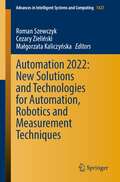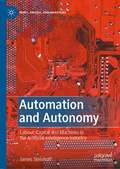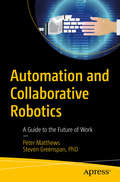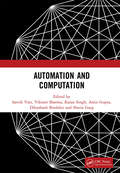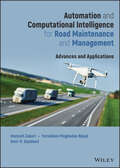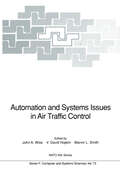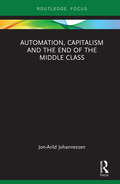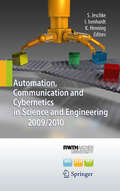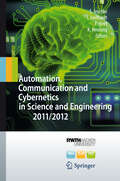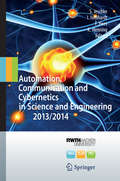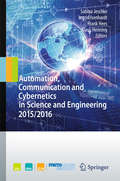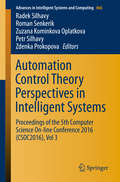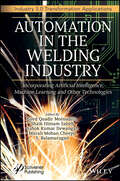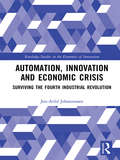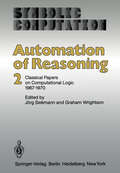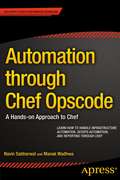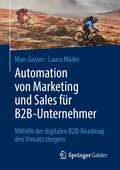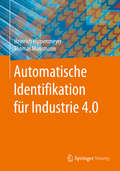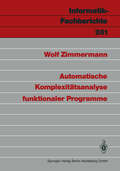- Table View
- List View
Automation 2022: New Solutions and Technologies for Automation, Robotics and Measurement Techniques (Advances in Intelligent Systems and Computing #1427)
by Roman Szewczyk Cezary Zieliński Małgorzata KaliczyńskaThis book presents the unique result of discussion among interdisciplinary specialists facing recent industrial and economic challenges. It contains papers authored by both scientists and practitioners focused on an interdisciplinary approach to developing measuring techniques, robotic and mechatronic systems, industrial automation, numerical modelling and simulation, and application of artificial intelligence techniques required by the transformation leading to Industry 4.0. We strongly believe that the solutions and guidelines presented in this book will be useful to both researchers and engineers facing problems associated with developing cyber-physical systems for global development.
Automation and Autonomy: Labour, Capital and Machines in the Artificial Intelligence Industry (Marx, Engels, and Marxisms)
by James SteinhoffThis book argues that Marxist theory is essential for understanding the contemporary industrialization of the form of artificial intelligence (AI) called machine learning. It includes a political economic history of AI, tracking how it went from a fringe research interest for a handful of scientists in the 1950s to a centerpiece of cybernetic capital fifty years later. It also includes a political economic study of the scale, scope and dynamics of the contemporary AI industry as well as a labour process analysis of commercial machine learning software production, based on interviews with workers and management in AI companies around the world, ranging from tiny startups to giant technology firms. On the basis of this study, Steinhoff develops a Marxist analysis to argue that the popular theory of immaterial labour, which holds that information technologies increase the autonomy of workers from capital, tending towards a post-capitalist economy, does not adequately describe the situation of high-tech digital labour today. In the AI industry, digital labour remains firmly under the control of capital. Steinhoff argues that theories discerning therein an emergent autonomy of labour are in fact witnessing labour’s increasing automation.
Automation and Collaborative Robotics: A Guide to the Future of Work
by Peter Matthews Steven GreenspanUnderstand the current and future research into technologies that underpin the increasing capabilities of automation technologies and their impact on the working world of the future.Rapid advances in automation and robotics technologies are often reported in the trade and general media, often relying on scary headlines such as “Jobs Lost to Robots.” It is certainly true that work will change with the advent of smarter and faster automated workers; however, the scope and scale of the changes is still unknown. Automation may seem to be here already, but we are only at the early stages. Automation and Collaborative Robotics explores the output of current research projects that are improving the building blocks of an automated world. Research into collaborative robotics (cobotics) is merging digital, audio, and visual data to generate a commonly held view between cobots and their human collaborators. Low-power machine learning at the edge of the network can deliver decision making on cobots or to their manipulations. Topics covered in this book include: Robotic process automation, chatbots, and their impact in the near futureThe hype of automation and headlines leading to concerns over the future of workComponent technologies that are still in the research labsFoundational technologies and collaboration that will enable many tasks to be automated with human workers being re-skilled and displaced rather than replaced What You Will Learn Be aware of the technologies currently being researched to improve or deliver automationUnderstand the impact of robotics, other automation technologies, and the impact of AI on automationGet an idea of how far we are from implementation of an automated futureKnow what work will look like in the future with the deployment of these technologies Who This Book Is For Technical and business managers interested in the future of automation and robotics, and the impact it will have on their organizations, customers, and the business world in general
Automation and Computation: Proceedings of the International Conference on Automation and Computation, (AutoCom 2022), Dehradun, India
by Satvik Vats Vikrant Sharma Karan Singh Amit Gupta Dibyahash Bordoloi Navin GargThe proceedings of the International Conference on Automation and Computation 2022 (AUTOCOM-22) consist of complete research articles that were presented at the conference. Each of the research articles was double-blind reviewed by the experts of the corresponding domain. The book contains a blend of problems and respective solutions related to computer-based automation & computation to highlight the recent technological developments in computer-based automation. It serves as an environment for researchers to showcase the latest research results on Data Science & Engineering, Computing Technologies, Computational Intelligence, Communication & Networking, Signal & Image Processing, Intelligent Control Systems & Optimization, Robotics and Automation, Power, Energy & Power Electronics, Healthcare & Computation, AI for human interaction, etc. It aims to give deep insight into the current trends of research in science and technology and shall introduce the reader to the new problems and respective approaches toward the solution and shall enlighten the researchers, students and academicians about the research being carried out in the field.
Automation and Computation: Proceedings of the International Conference on Automation and Computation, (AutoCom 2022), Dehradun, India
by Satvik Vats Sharma Vikrant Karan Singh Amit Gupta Dibyahash Bordoloi Navin GargThe proceedings of the International Conference on Automation and Computation 2022 (AUTOCOM-22) consist of complete research articles that were presented at the conference. Each of the research articles was double-blind reviewed by the experts of the corresponding domain. The book contains a blend of problems and respective solutions related to computer-based automation & computation to highlight the recent technological developments in computer-based automation. It serves as an environment for researchers to showcase the latest research results on Data Science & Engineering, Computing Technologies, Computational Intelligence, Communication & Networking, Signal & Image Processing, Intelligent Control Systems & Optimization, Robotics and Automation, Power, Energy & Power Electronics, Healthcare & Computation, AI for human interaction, etc. It aims to give deep insight into the current trends of research in science and technology and shall introduce the reader to the new problems and respective approaches toward the solution and shall enlighten the researchers, students and academicians about the research being carried out in the field.
Automation and Computational Intelligence for Road Maintenance and Management: Advances and Applications
by Hamzeh Zakeri Fereidoon Moghadas Nejad Amir H. GandomiAutomation and Computational Intelligence for Road Maintenance and Management A comprehensive computational intelligence toolbox for solving problems in infrastructure management In Automation and Computational Intelligence for Road Maintenance and Management, a team of accomplished researchers delivers an incisive reference that covers the latest developments in computer technology infrastructure management. The book contains an overview of foundational and emerging technologies and methods in both automation and computational intelligence, as well as detailed presentations of specific methodologies. The distinguished authors emphasize the most recent advances in the maintenance and management of infrastructure robotics, automated inspection, remote sensing, and the applications of new and emerging computing technologies, including artificial intelligence, evolutionary computing, fuzzy logic, genetic algorithms, knowledge discovery and engineering, and more. Automation and Computational Intelligence for Road Maintenance and Management explores a universal synthesis of the cutting edge in parameters and indices to evaluate models. It also includes: Thorough introductions to management science and the latest methods of automation and the structure and framework of automation and computing intelligence Comprehensive explorations of advanced image processing techniques, recent advances in fuzzy, and diagnosis automation Practical discussions of segmentation and fragmentation and different types of features and feature extraction methods In-depth examinations of methods of classification along with various developed methodologies and models of quantification, evaluation, and indexing in automation Perfect for postgraduate students in road and transportation engineering, evaluation, and assessment, Automation and Computational Intelligence for Road Maintenance and Management will also earn a place in the libraries of researchers interested in or working with the evaluation and assessment of infrastructure.
Automation and Computational Intelligence for Road Maintenance and Management: Advances and Applications
by Hamzeh Zakeri Fereidoon Moghadas Nejad Amir H. GandomiAutomation and Computational Intelligence for Road Maintenance and Management A comprehensive computational intelligence toolbox for solving problems in infrastructure management In Automation and Computational Intelligence for Road Maintenance and Management, a team of accomplished researchers delivers an incisive reference that covers the latest developments in computer technology infrastructure management. The book contains an overview of foundational and emerging technologies and methods in both automation and computational intelligence, as well as detailed presentations of specific methodologies. The distinguished authors emphasize the most recent advances in the maintenance and management of infrastructure robotics, automated inspection, remote sensing, and the applications of new and emerging computing technologies, including artificial intelligence, evolutionary computing, fuzzy logic, genetic algorithms, knowledge discovery and engineering, and more. Automation and Computational Intelligence for Road Maintenance and Management explores a universal synthesis of the cutting edge in parameters and indices to evaluate models. It also includes: Thorough introductions to management science and the latest methods of automation and the structure and framework of automation and computing intelligence Comprehensive explorations of advanced image processing techniques, recent advances in fuzzy, and diagnosis automation Practical discussions of segmentation and fragmentation and different types of features and feature extraction methods In-depth examinations of methods of classification along with various developed methodologies and models of quantification, evaluation, and indexing in automation Perfect for postgraduate students in road and transportation engineering, evaluation, and assessment, Automation and Computational Intelligence for Road Maintenance and Management will also earn a place in the libraries of researchers interested in or working with the evaluation and assessment of infrastructure.
Automation and Systems Issues in Air Traffic Control (NATO ASI Subseries F: #73)
by John A. Wise V. David Hopkin Marvin L. SmithIn recent years, increases in the amount and changes in the distribution of air traffic have been very dramatic and are continuing. The need for changes in the current air traffic systems is equally clear. While automation is generally accepted as a method of improving system safety and performance, high levels of automation in complex human-machine systems can have a negative effect on total system performance and have been identified as contributing factors in many accidents and failures. Those responsible for designing the advanced air traffic control systems to be implemented throughout the alliance during the next decade need to be aware of recent progress concerning the most effective application of automation and artificial intelligence in human-computer systems. This volume gives the proceedings of the NATO Advanced Study Institute held in Maratea, Italy, June 18-29, 1990, at which these issues were discussed.
Automation and Utopia: Human Flourishing in a World without Work
by John DanaherAutomating technologies threaten to usher in a workless future, but John Danaher argues that this can be a good thing. A world without work may be a kind of utopia, free of the misery of the job and full of opportunities for creativity and exploration. If we play our cards right, automation could be the path to idealized forms of human flourishing.
Automation, Capitalism and the End of the Middle Class (Routledge Focus on Economics and Finance)
by Jon-Arild JohannessenIn this book, the author argues that a new form of capitalism is emerging at the threshold of the Fourth Industrial Revolution. He asserts that we are in the midst of a transition from democratic capitalism to feudal capitalism and highlights how robotization and innovation is leading to a social crisis for the middle classes as economic inequality is on the rise. Johannessen outlines the three elements – Balkanization, the Great Illusion, and the plutocracy – which are referred to here as feudal structures. He describes, analyzes, and discusses these elements both individually and in interaction with each other, and asks: "What structures and processes are promoting and boosting feudal capitalism?" Additionally, the book serves to generate knowledge about how the middle class will develop in the Fourth Industrial Revolution. It shows the various effects of robotization on the middle class, where middle class jobs are transformed, deconstructed, and re-constructed and new part-time jobs are created for the middle class. Given the interest in the Fourth Industrial Revolution, the book will appeal to students of economic sociology and political economy as well as those in innovation and knowledge management courses focusing upon the emerging innovation economy. The topic will attract policymakers, and the accessible and engaging tone will also make the book of interest to the general public.
Automation, Capitalism and the End of the Middle Class (Routledge Focus on Economics and Finance)
by Jon-Arild JohannessenIn this book, the author argues that a new form of capitalism is emerging at the threshold of the Fourth Industrial Revolution. He asserts that we are in the midst of a transition from democratic capitalism to feudal capitalism and highlights how robotization and innovation is leading to a social crisis for the middle classes as economic inequality is on the rise. Johannessen outlines the three elements – Balkanization, the Great Illusion, and the plutocracy – which are referred to here as feudal structures. He describes, analyzes, and discusses these elements both individually and in interaction with each other, and asks: "What structures and processes are promoting and boosting feudal capitalism?" Additionally, the book serves to generate knowledge about how the middle class will develop in the Fourth Industrial Revolution. It shows the various effects of robotization on the middle class, where middle class jobs are transformed, deconstructed, and re-constructed and new part-time jobs are created for the middle class. Given the interest in the Fourth Industrial Revolution, the book will appeal to students of economic sociology and political economy as well as those in innovation and knowledge management courses focusing upon the emerging innovation economy. The topic will attract policymakers, and the accessible and engaging tone will also make the book of interest to the general public.
Automation, Communication and Cybernetics in Science and Engineering 2009/2010
by Sabina Jeschke Ingrid Isenhardt Klaus HenningThe book presents a representative selection of all publications published between 01/2009 and 06/2010 in various books, journals and conference proceedings by the researchers of the institute cluster: IMA - Institute of Information Management in Mechanical Engineering ZLW - Center for Learning and Knowledge Management IfU - Institute for Management Cybernetics, Faculty of Mechanical Engineering, RWTH Aachen University The contributions address the cluster's five core research fields: suitable processes for knowledge- and technology-intensive organizations, next-generation teaching and learning concepts for universities and the economy, cognitive IT-supported processes for heterogeneous and cooperative systems, target group-adapted user models for innovation and technology development processes, semantic networks and ontologies for complex value chains and virtual environments Innovative fields of application such as cognitive systems, autonomous truck convoys, telemedicine, ontology engineering, knowledge and information management, learning models and technologies, organizational development and management cybernetics are presented. The contributions show the unique potential of the broad and interdisciplinary research approach of the ZLW/IMA and the IfU.
Automation, Communication and Cybernetics in Science and Engineering 2011/2012
by Sabina Jeschke Ingrid Isenhardt Frank Hees Klaus HenningThe book is the follow-up to its predecessor “Automation, Communication and Cybernetics in Science and Engineering 2009/2010” and includes a representative selection of all scientific publications published between 07/2011 and 06/2012 in various books, journals and conference proceedings by the researchers of the following institute cluster:IMA - Institute of Information Management in Mechanical EngineeringZLW - Center for Learning and Knowledge ManagementIfU - Associated Institute for Management CyberneticsFaculty of Mechanical Engineering, RWTH Aachen UniversityInnovative fields of application, such as cognitive systems, autonomous truck convoys, telemedicine, ontology engineering, knowledge and information management, learning models and technologies, organizational development and management cybernetics are presented.
Automation, Communication and Cybernetics in Science and Engineering 2013/2014
by Sabina Jeschke Ingrid Isenhardt Frank Hees Klaus HenningThis book continues the tradition of its predecessors “Automation, Communication and Cybernetics in Science and Engineering 2009/2010 and 2011/2012” and includes a representative selection of scientific publications from researchers at the institute cluster IMA/ZLW & IfU. IMA - Institute of Information Management in Mechanical Engineering ZLW - Center for Learning and Knowledge Management IfU - Associated Institute for Management Cybernetics e.V. Faculty of Mechanical Engineering, RWTH Aachen University The book presents a range of innovative fields of application, including: cognitive systems, cyber-physical production systems, robotics, automation technology, machine learning, natural language processing, data mining, predictive data analytics, visual analytics, innovation and diversity management, demographic models, virtual and remote laboratories, virtual and augmented realities, multimedia learning environments, organizational development and management cybernetics. The contributions selected reflect the fundamental paradigm shift toward an increasingly interdisciplinary research world – which has always been both the basis and spirit of the institute cluster IMA/ZLW & IfU.
Automation, Communication and Cybernetics in Science and Engineering 2015/2016
by Sabina Jeschke Ingrid Isenhardt Frank Hees Klaus HenningAutomation, Communication and Cybernetics in Science and Engineering
Automation Control Theory Perspectives in Intelligent Systems: Proceedings of the 5th Computer Science On-line Conference 2016 (CSOC2016), Vol 3 (Advances in Intelligent Systems and Computing #466)
by Radek Silhavy Roman Senkerik Zuzana Kominkova Oplatkova Petr Silhavy Zdenka ProkopovaThe volume Automation Control Theory Perspectives in Intelligent Systems presents new approaches and methods to real-world problems, and in particular, exploratory research that describes novel approaches in the field of cybernetics and automation control theory. Particular emphasis is laid on modern trends in intelligent information technology, system monitoring and proactive management of complex objects The 5th Computer Science On-line Conference (CSOC2016) is intended to provide an international forum for discussions on the latest high-quality research results in all areas related to Computer Science. The addressed topics are the theoretical aspects and applications of Computer Science, Artificial Intelligences, Cybernetics, Automation Control Theory and Software Engineering.
Automation in the Welding Industry: Incorporating Artificial Intelligence, Machine Learning and Other Technologies (Industry 5.0 Transformation Applications)
by Syed Quadir Moinuddin Shaik Himam Saheb Ashok Kumar Dewangan Murali Mohan Cheepu S. BalamuruganAUTOMATION IN THE WELDING INDUSTRY This volume serves as a multidimensional perspective of welding practices in Industry 5.0 from the perspective of automation, digitization, digital twins, cobots, virtual reality, augmented reality, machine learning, artificial intelligence, and IoT ranging from rudiments to advanced applications. This book introduces the concept of Industry 5.0 in welding technologies, where the human brain collaborates with robots to achieve rapid productivity and economic efficiency. It presents the latest information on adapting and integrating Industry 5.0 in welding industries through critical constituents such as artificial intelligence (AI), machine learning (ML), Internet of Things (IoT), digital twin, augmented and virtual reality (AR & VR), and collaborative robots (Cobots), towards intelligent welding systems. The chapter authors have comprehensively addressed the issues related to welding industries such as a shortage of welders, challenges in critical applications, creating defect-free and quality products through real-time monitoring, feedback systems, and in situ adjustments, etc. The utilization of cobots in welding technology is addressed in real-world problems to move towards a green welding environment (i.e., minimal fumes with less shielding gas) and thereby, less energy consumption. Two or more welding processes are combined to form a hybrid process where the compatibility of existing materials and novel materials can be used in 3D, 4D, and 5D printing of complex geometries. Audience Engineering research scholars, industry welding, and additive manufacturing groups. A diverse group of industries will be interested in this book, such as medical, automotive, construction, pipeline, shipping, aerospace, etc.
Automation in the Welding Industry: Incorporating Artificial Intelligence, Machine Learning and Other Technologies (Industry 5.0 Transformation Applications)
by Syed Quadir Moinuddin Shaik Himam Saheb Ashok Kumar Dewangan Murali Mohan Cheepu S. BalamuruganAUTOMATION IN THE WELDING INDUSTRY This volume serves as a multidimensional perspective of welding practices in Industry 5.0 from the perspective of automation, digitization, digital twins, cobots, virtual reality, augmented reality, machine learning, artificial intelligence, and IoT ranging from rudiments to advanced applications. This book introduces the concept of Industry 5.0 in welding technologies, where the human brain collaborates with robots to achieve rapid productivity and economic efficiency. It presents the latest information on adapting and integrating Industry 5.0 in welding industries through critical constituents such as artificial intelligence (AI), machine learning (ML), Internet of Things (IoT), digital twin, augmented and virtual reality (AR & VR), and collaborative robots (Cobots), towards intelligent welding systems. The chapter authors have comprehensively addressed the issues related to welding industries such as a shortage of welders, challenges in critical applications, creating defect-free and quality products through real-time monitoring, feedback systems, and in situ adjustments, etc. The utilization of cobots in welding technology is addressed in real-world problems to move towards a green welding environment (i.e., minimal fumes with less shielding gas) and thereby, less energy consumption. Two or more welding processes are combined to form a hybrid process where the compatibility of existing materials and novel materials can be used in 3D, 4D, and 5D printing of complex geometries. Audience Engineering research scholars, industry welding, and additive manufacturing groups. A diverse group of industries will be interested in this book, such as medical, automotive, construction, pipeline, shipping, aerospace, etc.
Automation, Innovation and Economic Crisis: Surviving the Fourth Industrial Revolution (Routledge Studies in the Economics of Innovation)
by Jon-Arild JohannessenThe fourth industrial revolution is developing globally, with no geographical centre. It is also taking place at enormous speed. This development will shape the workplaces of the future, which will be entirely different from the workplaces created by the first, second and third industrial revolutions. Industry created the industrial worker. The knowledge society will create a new type of "industrial worker", the knowledge worker. While the third industrial revolution was concerned with the digitalization of work, in the fourth industrial revolution, robots will bring about the informatization of work. Many of these robots will be systematically connected, such that they can obtain updated information and learn from their own and others’ mistakes. The way we work, where we work, what we work on, and our relationships with our colleagues and employers are all in a state of change. The workplace of the future will not necessarily be a fixed geographical location, but may be geographically distributed and functionally divided. In his book, Jon-Arild Johannessen argues that a "perfect" social storm occurs when inequality grows at a catastrophic rate, unemployment increases, job security is threatened for a growing number and robotization takes over even the most underpaid jobs. Thus, the ingredients for a perfect social storm will be brought forward by cascades of innovations that will most likely lead to economic and social crises and he argues that it is reasonable to assume that it will only take a small spark for this social storm to develop into a social revolution.
Automation, Innovation and Economic Crisis: Surviving the Fourth Industrial Revolution (Routledge Studies in the Economics of Innovation)
by Jon-Arild JohannessenThe fourth industrial revolution is developing globally, with no geographical centre. It is also taking place at enormous speed. This development will shape the workplaces of the future, which will be entirely different from the workplaces created by the first, second and third industrial revolutions. Industry created the industrial worker. The knowledge society will create a new type of "industrial worker", the knowledge worker. While the third industrial revolution was concerned with the digitalization of work, in the fourth industrial revolution, robots will bring about the informatization of work. Many of these robots will be systematically connected, such that they can obtain updated information and learn from their own and others’ mistakes. The way we work, where we work, what we work on, and our relationships with our colleagues and employers are all in a state of change. The workplace of the future will not necessarily be a fixed geographical location, but may be geographically distributed and functionally divided. In his book, Jon-Arild Johannessen argues that a "perfect" social storm occurs when inequality grows at a catastrophic rate, unemployment increases, job security is threatened for a growing number and robotization takes over even the most underpaid jobs. Thus, the ingredients for a perfect social storm will be brought forward by cascades of innovations that will most likely lead to economic and social crises and he argues that it is reasonable to assume that it will only take a small spark for this social storm to develop into a social revolution.
Automation of Reasoning: 2: Classical Papers on Computational Logic 1967–1970 (Symbolic Computation)
by J. Siekmann G. Wrightson"Kind of crude, but it works, boy, it works!" AZan NeweZZ to Herb Simon, Christmas 1955 In 1954 a computer program produced what appears to be the first computer generated mathematical proof: Written by M. Davis at the Institute of Advanced Studies, USA, it proved a number theoretic theorem in Presburger Arithmetic. Christmas 1955 heralded a computer program which generated the first proofs of some propositions of Principia Mathematica, developed by A. Newell, J. Shaw, and H. Simon at RAND Corporation, USA. In Sweden, H. Prawitz, D. Prawitz, and N. Voghera produced the first general program for the full first order predicate calculus to prove mathematical theorems; their computer proofs were obtained around 1957 and 1958, about the same time that H. Gelernter finished a computer program to prove simple high school geometry theorems. Since the field of computational logic (or automated theorem proving) is emerging from the ivory tower of academic research into real world applications, asserting also a definite place in many university curricula, we feel the time has corne to examine and evaluate its history. The article by Martin Davis in the first of this series of volumes traces the most influential ideas back to the 'prehistory' of early logical thought showing how these ideas influenced the underlying concepts of most early automatic theorem proving programs.
Automation through Chef Opscode: A Hands-on Approach to Chef
by Navin Sabharwal Manak WadhwaAutomation through Chef Opscode provides an in-depth understanding of Chef, which is written in Ruby and Erlang for configuration management, cloud infrastructure management, system administration, and network management. Targeted at administrators, consultants, and architect, the book guides them through the advanced features of the tool which are necessary for infrastructure automation, devops automation, and reporting. The book presumes knowledge of Ruby and Erlang which are used as reference languages for creating recipes and cookbooks and as a refresher on them to help the reader get on speed with the flow of book. The book provides step by step instructions on installation and configuration of Chef, usage scenarios of Chef, in infrastructure automation by providing common scenarios like virtual machine provisioning, OS configuration for Windows, Linux, and Unix, provisioning and configuration of web servers like Apache along with popular databases like MySQL. It further elaborates on the creation of recipes, and cookbooks, which help in deployment of servers and applications to any physical, virtual, or cloud location, no matter the size of the infrastructure. The books covers advanced features like LWRPs and Knife and also contains several illustrative sample cookbooks on MySQL, Apache, and CouchDB deployment using a step by step approach.
Automation von Marketing und Sales für B2B-Unternehmer: Mithilfe der digitalen B2B-Roadmap den Umsatz steigern
by Marc Gasser Laura MäderDie Automation von Marketing und Sales ist in Zukunft erfolgsentscheidend. Nur so können B2B-Unternehmen dem Wettbewerbsdruck weiterhin standhalten. Doch der Aufbau eines digitalen Marketing- und Salesprozesses ist aufwendig und komplex und stellt insbesondere kleinere B2B-Unternehmen vor die herausfordernde Frage: Wie kann die Digitalisierung möglichst kosteneffizient vorangetrieben werden? Anhand von Erfahrungswerten aus über 100 B2B-Digitalisierungsprojekten haben Laura Mäder und Marc Gasser das Modell der digitalen B2B-Roadmap entwickelt – eine Schritt-für-Schritt-Anleitung für die Planung, Steuerung und Skalierung von digitalem Marketing und Sales. Mithilfe der digitalen B2B-Roadmap Leads automatisiert entlang der Customer-Journey führen, einen Wettbewerbsvorteil erreichen und den Umsatz steigern. Dieses Buch ist für B2B-Unternehmer, Visionäre und Impulsgeber, die veraltete Marketing- und Salesmodelle auf den Kopf stellen und Innovation effizient vorantreiben wollen.
Automatische Identifikation für Industrie 4.0
by Heinrich Hippenmeyer Thomas MoosmannDie Autoren gehen in diesem Buch darauf ein, welche Herausforderungen mit "Industrie 4.0" auf Industriepraktiker zukommen. Wie und mit welchen Zielsetzungen können Entwicklungen in mittelständischen Unternehmen aufgegriffen werden? Die Geräte zur automatischen Identifikation als Teil der Prozesssteuerung und Systemplanung der Intralogistik, zur Einbindung in das Netzwerk im Unternehmen und mit Partnern, sind Kumulationspunkte vieler Probleme in kleinen und mittelständischen Unternehmen. Diesen wird dargelegt wo und wie in den automatisierten Unternehmensbereichen Schritte zur "digitalen" Fabrik bereits vollzogen wurden und wie die Einbindung der betrieblichen Intralogistik in das firmenweite Netzwerk und damit in das ERP-System erfolgen kann.
Automatische Komplexitätsanalyse funktionaler Programme (Informatik-Fachberichte #261)
by Wolf ZimmermannEs gibt im Bereich der Softwaretechnik viele Werkzeuge, die den Programmentwicklungsprozeß unterstützen. Sie stellen die Korrektheit der Implementierung sicher, nicht aber ihre Effizienz. Die vorliegende Arbeit führt daher eine Methode ein, die es erlaubt, die Zeitkomplexität funktionaler Programme automatisch zu ermitteln. Die Grundidee dieser Methode besteht darin, ein funktionales Programm in ein System von Rekurrenzgleichungen zu übersetzen, dessen Lösung das Zeitverhalten des Programms angibt. Durch Einführung von bedingten Rekurrenzen und Rekurrenzfamilien ist es möglich, obere und untere Schranken für die Zeitkomplexität zu finden. Um die mittlere Zeitkomplexität zu bestimmen, müssen Wahrscheinlichkeiten dafür berechnet werden, daß im Programm vorkommende Bedingungen wahr bzw. falsch werden. Diese Wahrscheinlichkeiten werden anhand einer probabilistischen Semantik des Programms berechnet. Um möglichst genaue Schranken für die Zeitkomplexität zu erhalten, muß eine Abhängigkeitsanalyse durchgeführt werden. Dies ermöglicht eine genaue Analyse von Divide-and-Conquer-Programmen.
